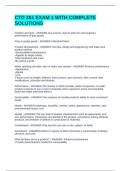CTD 261 EXAM 1 WITH COMPLETE
SOLUTIONS
Finishes and dyes - ANSWER-Any process used to add color and augment
performance of gray goods
Gray or greige goods - ANSWER-Unfinished fabric
Product Development - ANSWER-The jobs, design and engineering, that make sure
product can/has
-Serviceability characteristics
-Appeals to target market
-Meet timeframe and costs
-Be sold at a profit
When selecting one fiber, yarn or fabric over another - ANSWER-Products performance
-Appearance
-Appeal
-Cost
-Factors such as weight, stiffness, hand, texture, yarn structure, fiber content, fiber
modifications, coloration and finishes
Performance - ANSWER-The manner in which a textile, textile component, or textile
product responds to use or how it responds when exposed to some environmental
factor that might adversely affect it
Serviceability - ANSWER-The measure of a textile product's ability to meet consumers'
needs
Needs - ANSWER-Aesthetics, durability, comfort, safety, appearance, retention, care,
environmental impact, cost
Quality - ANSWER-The sum total of product characteristics such as appearance, end
use, performance, interactions of materials in the product, consistency among identical
products, and freedom of defects in construction or materials
Confinement - ANSWER-Only one firm can use a color, pattern, or fabric
Assortment - ANSWER-Refers to a group of fabric that share a commonality of design,
structure, and color
What do fibers do for a product? - ANSWER--Influence performance
-Provide characteristics needed for serviceability
,-Need to be readily available
-Cost-effective
-Constant supply
Natural Fibers - ANSWER-Fibers grown or developed in nature in recognizable forms.
ALL natural fibers are staple fibers, except for silk
Manufactured or Man-made Fibers - ANSWER-Made from chemical compounds
produced in manufacturing facilities, original form not recognizable as a fiber.
ALL manufactured fibers are produced in filament form, but many are cut into short,
staple lengths for further processing
Filament - ANSWER-Long, continuous fiber (monofilament, multifilament)
Filament Tow - ANSWER-Filaments crimped, then cut
Staple fibers - ANSWER-Fibers are of short, finite length, generally less than 10"
Diameter - ANSWER-Affects fabric performance and hand
Micrometer - ANSWER-Unit of measurement for fineness of natural fibers, equaling
1x10 to -6 of a meter or a millionth, or one-thousandth of a millimeter, .001 mm
Denier - ANSWER-Weight, in grams, per 9000 meters; manufactured fibers and yarns,
small number finer fiber
Tex - ANSWER-Weight in grams of 1000m of fiber and yarns, smaller number finer fiber
Cross-section shape - ANSWER-Fiber Shape affects luster, bulk, body, texture, hand,
etc
Surface contour - ANSWER-Describes outer surface of the fiber, i.e. smooth, rough,
serrated, etc.
(Affects: luster, hand texture and apparent soiling)
Crimp
1) Fiber crimp
2) Fabric crimp - ANSWER-The three-dimensional shape of the fiber
1) waves and twists along the fiber
2) bend caused by distortion of yarns due to weaving and knitting
Fiber parts - ANSWER-Complex for natural fibers; simple for manufactured fibers
Polymerization - ANSWER-Process of joining many small molecules (monomers) to
form one large compound
, Degree of polymerization - ANSWER-The number of monomers connected to form
polymer
Amorphous - ANSWER-Polymer chains arranged in a random, disorganized way, not
parallel; fibers are weak, flexible, absorbent; low elastic, but good elongation properties
Crystalline - ANSWER-Polymer chains are parallel, affect strength of fiber
Density or specific gravity - ANSWER-Measure of fiber weight per unit volume
Resiliency - ANSWER-Ability to return to original shape after bending, twisting, or
crushing
Dimensional stability - ANSWER-Ability to retain given size and shape through use and
care
Shrinkage resistance - ANSWER-Ability of fabric to retain given size through care or
cleaning
Elasticity or elastic recovery - ANSWER-Ability of extended fiber, yarn, or fabric to
return immediately to its original length
Orientation - ANSWER-Polymer chains parallel to each other and to the fiber's
longitudinal axis; stiff, nonabsorbent; low elongation, good elasticity
Stretching or drawing - ANSWER-Increase fiber orientation and crystallinity
Hydrogen bonds - ANSWER-Attraction between positive hydrogen and negative oxygen
or nitrogen of adjacent chains
Van der waals - ANSWER-Weak bonds between atoms of adjacent chains
Luster - ANSWER-Sheen caused by light reflected from a fiber's surface
Drape - ANSWER-The manner in which a fabric hangs over a form
Texture - ANSWER-Nature of a textile's surface
Hand - ANSWER-How a textile feels to the touch
Abrasion resistance - ANSWER-Ability to withstand rubbing and folding
Flexibility - ANSWER-Ability to bend repeatedly without breaking
Tenacity - ANSWER-Ability to withstand a heavy pulling force




